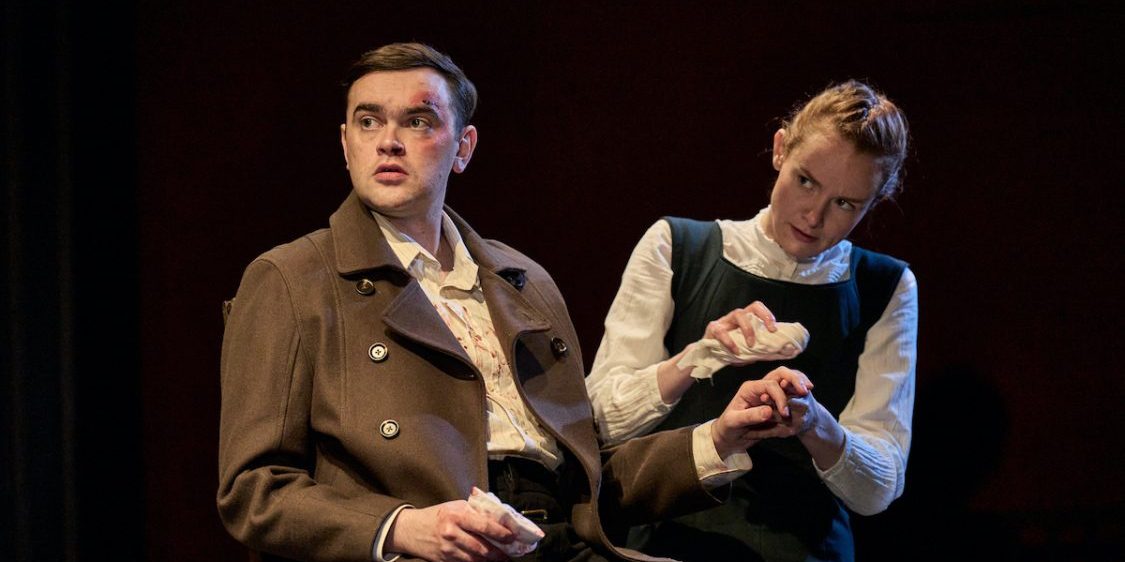After the success of her ‘James Trilogy’ any new historical drama by Rona Munro arrives with high expectations. Building on the insight that Scotland lacks a ‘boxed set’ of history plays akin to Shakespeare’s coverage of England, she has assembled a fascinating sequence of dramas that blend rigorous history with contemporary modern dialogue, a very hard tightrope to walk.
‘Mary’ offers a rather different set of challenges – here the history is all too well known. Any airport bookshop boasts several biographies or novels that retell the manifold complicated twists and turns in the life and brief reign of Mary, Queen of Scots. Films and biopics abound. Nor is this new – Schiller, Donizetti and many others made her the focus of dramas and operas. With so many different takes, what room is there for another?
Munro’s strategy is two-fold: firstly, she looks at Mary obliquely through the eyes of three characters who encountered her – and her always chequered reputation – in different ways. Mary herself drifts into the action in person only on two occasions. And secondly the focus rests on particular disputed events that centre on her vulnerability as a woman who is also a ruler. As a result, we are encouraged to think not so much about the characters but about present-day themes that emerge from the history – the meaning of consent, fake news, violence against women, suppression of female voices, and why those who are morally good acquiesce in evil.
The play possesses real merits: we are surprised and provoked in a narrative where we thought there could be no more surprises; and we can observe and admire the skilful ways in which Munro shifts the balance of power between the three characters, each of whom embodies a different viewpoint and reaction to events. But it does also sometimes mean that the drama itself is more told than shown, becoming visually becalmed, and heavily reliant on the quality of the acting (here – fortunately – very high!) to prevent the pace and interest from flagging.
There are two scenes – set in April and June 1567 – and both centre on the actions and reactions of Sir James Melville, a devoted and loyal courtier of Mary’s, who seeks to defend her from the charges of immorality, overt favouring of Catholicism during the Protestant Reformation, and political opportunism. He is challenged by an eloquent, radical Protestant servant girl, played with fierce precision of word and thought by Rona Morison, and an upwardly mobile soldier who rises to political influence, a role taken by Brian Vernel. Both characters represent ‘views from below’ from people who know Mary only by public reputation and who have their own agendas – the one to reshape Scotland through religious zeal, the other simply wanting to use the unstable times as a way to gain promotion.
James Melville is a huge role that dominates the action and thus the success of the evening rests very much on the shoulders of the actor taking on the challenge. The play is fortunate to have Douglass Henshall in the role. His approach is to channel strong, repressed emotion through the startling eloquence and picture-painting of his speeches. His intense, pent-up self-reproachful stance acts as a slow burn throughout the action. He gradually shifts from being a traditional commanding authority figure motivated by a genuine love and respect for Mary. He evolves from imposing his view of the world on those around him, to a position that is less assured and more accommodating to the times. The need to maintain his career as a diplomat comes to the fore, in part to cover up for his apparent failure to support Mary during her greatest hour of need. This portrait is an excellent demonstration of how even the most prominent of moral stances are driven by a mixture of motives, not always accessible even to the person in question.
While there are a few flat patches of exposition and infill, this play succeeds very well in making us think about Mary Queen of Scots afresh. Just as with her great rival, Elizabeth I, there will never be consensus – some will view her as a conniving, weak-willed conspirator with zero political judgement who brought her troubles on herself; while others will see her as a wronged heroine who played a weak political hand as well as she could and who suffered inordinate abuse and contempt from those who should have protected her. What is clear though is the extent to which her gender was consistently used against her and that even those from whom she might have expected support failed to provide it when it mattered. There are still some uncomfortable and thought-provoking contemporary parallels to reflect upon as you leave the theatre…

